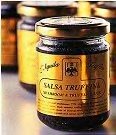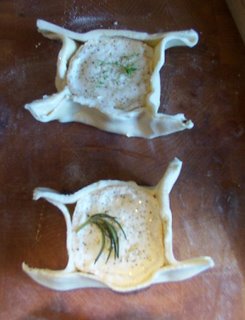
For those who have had the opportunity to smell fresh Truffle (see article about my truffle-hunting dog), it is an unforgettable scent that is primitively evocative. Indeed, it was a brave man who tried many things for the first time, not least of all, the grubby, nubbly truffle, which is nothing to look at, and in truth, probably smells quite repulsive to some people. However, he (or she) was rewarded with a gift from nature that is worth perhaps more than an emerald or ruby, assuming, of course, that he (or she) had impeccable culinary tastes.
It is almost impossible to fully describe the taste of a truffle, but it lends an indelibly savoury, muskiness to any dish that it is added to, whether as a grated flourish on top of risotto or, for the poorer man, some Salsa Truffina stirred into pasta.
I recently purchased a small glass jar of Salsa Truffina (literally, Truffle Sauce) from the exotic section of delicacies in Sainsbury’s but it is also available to buy online or from your local specialist food shop. I had wanted to try a recipe that I read about in Tessa Kiro’s Falling Cloudberries (which is a wonderful collection of recipes gathered from Sweden, Italy, Greece and South Africa. It is far more coherent and eclectic than her latest book, Apples for Jam, which looks lovely but is perhaps a bit too twee and simplified for some tastes), Spinach and Truffle Triangles, hence the purchase and before trying the sauce I did wonder if perhaps I had purchased an ingredient that was a touch too recherché to be ever used again. Not to mention it was £4.59, which is quite expensive, even if it is a truffle-based product in a perfectly darling little glass jar with lots of gold on it.
However, after devoting some time lovingly making the rough puff pastry (although, in fact, I actually knocked it up in my lunch-hour after walking my dogs and having lunch itself, and it still turned out delicious despite being rushed), which is really the only complicated part of the whole procedure I thought to myself: there’s no turning back now. After work, I started to prep dinner, which was a mushroom risotto (from Delia’s Winter Collection), so whilst the onions and mushrooms were sweating down, I started to roll out the pastry for the Truffle Pasties. I have detailed the full procedure below but if I can make rough puff pastry in 10 minutes flat, then so can anyone. I must confess that as I started the recipe, I thought the pastry was going to be a bog-standard shortcrust but as I went on, the folding and turning of the butter into the flour made me realise that I was already part way through making something a bit different that I had never made before and that yes, I had made the rash decision to prepare in my lunch-hour.
Anyway, the filling of these delectable morsels comprised of finely chopped spinach mixed with a tablespoon of the truffle sauce, some truffle oil and some diced Mozzarella. The pastry is cut into squares, filled with the mixture, folded into a triangle, brushed with egg and baked for about 10 minutes. It is incredibly hard to resist biting into one once removed from the oven but if you wait, the flavours develop and then pop! in your mouth. Furthermore, if you are worried about using up the rest of your Salsa Truffina, I could suggest using it with pasta,
Spinach and Truffle Triangles

Ingredients:
Pastry:
225g Plain Flour, sifted
225g Butter, chilled and cut into dice
Pinch Salt
Iced Water
Filling:
300g Fresh Spinach (cooked in boiling, salted water for five minutes, drained well, half chopped finely, half left as is)
1 Tablespoon Salsa Truffina
1 Teaspoon Truffle Oil
100g Finely Chopped Mozzarella
Salt and Pepper
1 Egg, beaten
METHOD
To make the pastry, sieve the flour into a large mixing bowl with the salt. Add the chilled, diced butter and stir through the flour with a knife until coated. Add enough of the iced water to bring the mixture together. Wodge together as well as you can an turn out onto a cold surface. Form a rough cube and flouring your board, hands, rolling pin and pastry well, roll out into a rectangle, then fold the two longest ends inwards and then in half. Repeat. The pastry is very sticky because the butter is not worked into the flour in the traditional manner (i.e. rubbing with your fingers). Roll into a thick rectangle, maybe 6 inches by 4 inches, wrap in cling-film and refrigerate for at least half an hour (preferably longer).
Preheat your oven to 180c.
To make the filling, mix the finely chopped spinach into the pearly white cubes of Mozzarella, add the Salsa Truffina, Truffle Oil, the rest of the spinach and season well.
Remove the pastry from the fridge. Once again flour your work surface, hands and rolling pin. Roll the rested pastry out until it is about 30cm x 30cm or thereabouts. I had to do mine in two lots, as my work surface is tiny!
The pastry should be very thin, maybe 1mm thick. Cut into squares 4” x 4” and place each square onto a baking tray. Put a tablespoon of mixture in the centre of each square and fold over the pastry over to form a triangle. Press down the edges firmly to seal and brush with egg yolk. This should make about 16 pastries, but I only ended up making 13 because of space limitations and also because the remaining pastry stuck to the board under the warmth of the lights. It is always the first rule of pastry making to keep things cold, cold, cold! Perhaps this is why pies are best in the wintertime?
Anyway, brush each of your fat, stuffed little triangles with beaten egg and place in the oven for 10-15 minutes or until golden brown and puffy but firm. Leave to cool for about 5 minutes (or as long as you can bear – remember they are filled with molten Mozzarella at this point!!). Eat them and weep.











